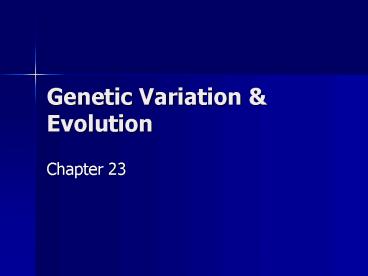Genetic Variation PowerPoint PPT Presentation
1 / 17
Title: Genetic Variation
1
Genetic Variation Evolution
- Chapter 23
2
What you need to know!
- How mutation and sexual reproduction each produce
genetic variation
3
Variation
- Variations exist between individuals in a given
population. The following are heritable - Mutation mostly point mutations (other
mutations are possible) - Sexual Reproduction crossing over, independent
assortment - Diploidy recessive alleles can be hidden (from
natural selection) but stay around
4
Variation
- Outbreeding mating with non-related partners
increases new allele combinations - Behavioral incest is blocked in most higher order
species - Balanced polymorphism different phenotypes in a
single population propagate natural selection - Heterozygous advantage advantage to
heterozygous alleles despite deadly recessive
alleles (ex. Sickle cell anemia)
5
Variation
- Hybrid Vigor superior quality of offspring when
crossing highly inbred strains - Frequency dependent selection predators form
search images fitting most common prey
phenotypes - http//evolution.berkeley.edu/evolibrary/article/h
appyface_11 - Neutral Variation no selection pressure for
certain phenotypes - Silent Mutations mutations that do not impact
phenotypes (no selection pressure)
6
Natural Selection
- Differential reproductive success of different
phenotypes as a result of the interaction with
the environment - Due to genetic variations certain phenotypes are
better or worse adapted - Survival depends on the adaptations (fitness)
- Reproduction depends on survival
7
Microevolution
- Def Natural selection causes changes in
relative frequencies of alleles in the gene pool
(Hardy Weinberg) - Adaptation means genes are selected to
- Increase (good)
- Decrease (bad)
- Stay the same (neutral)
- Evolution is the accumulation of advantageous
traits
8
Stabilizing Selection
- Extreme phenotypes are bad adapatations
- Example primate birth weight
- Too small and the baby dies
- Too large and the mother dies
- Draw
9
Directional Selection
- A single extreme adaptation is good
- Example peppered moths
- Draw
10
Diversifying Selection
- Selection against the common phenotype
- Selection for both extremes
- Example weeds are either very tall (difficult
to uproot) or very short (survive lawn mowers)
11
Sexual Selection
- Selection for sexual phenotypes
- Male competition fittest male mates most
(antlers, horns, body size) - Female choice attractiveness and mating
behavior - Sexual dimorphism diifferent appearance of
males and females in certain species
12
Artificial Selection
- Directional selection carried out by humans
- Humans select a desireable trait and only breed
animals with the selected trait (dogs, cats,
sheep, horses, cows, etc.)
13
Imperfection
- Natural selection does not fashion the perfect
organism because - Selection only edits existing variation
- Evolution is limited by historical constraints
- Adaptations are often compromises
- Change, natural selection and the environment
interact
14
Homework
- Concept Checks 23.1 (pg. 458)
- What did Mendels findings about genetics add to
Darwins theory of evolution by natural
selection? - Suppose a population or organisms with 500 gene
loci is fixed at half of these loci. How many
alleles are found in its gene pool? Explain. - Which parts of the Hardy-Weinberg equation (p2
2pq q2 1) correspond to the frequency of
individuals that have at least one PKU allele?
15
Homework
- Concept Checks 23.2 (pg. 460)
- Of all the mutations that occur, why do only a
small fraction become widespread in a gene pool? - How does sexual recombination produce variation?
16
Homework
- Concept Checks 23.3 (pg. 462)
- In what sense is natural selection more
predictable than genetic drift? - Distinguish genetic drift and gene flow in terms
of (a) how they occur and (b) their implications
for future genetic variation in a population.
17
Homework
- Concept Checks 23.4 (pg. 470)
- Does nucleotide variability in a population
always correspond to phenotypic polymorphism?
Why or why not? - What is the relative fitness of a sterile mule?
Explain. - How does sexual selection lead to sexual
dimorphism? - Explain what is meant by the reproductive
handicap of sex.

